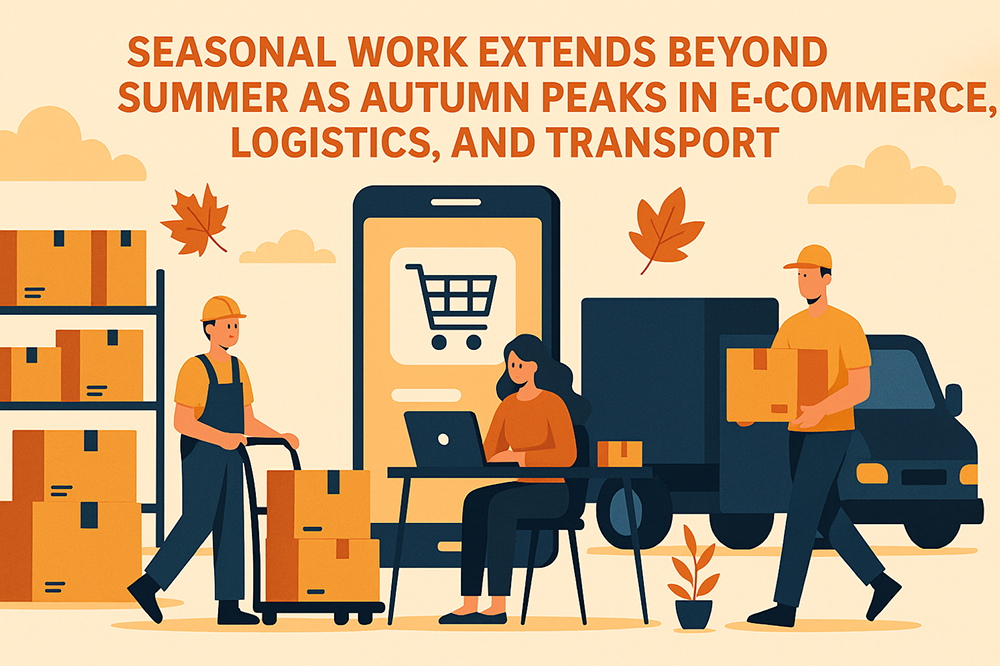Seasonal work extends beyond summer as autumn peaks in e-commerce, logistics and transport
While seasonal employment is traditionally associated with the summer months, demand for temporary workers also surges during other periods of the year—most notably in autumn. According to analysis by Personnel Service, employment in the e-commerce sector can double between September and November due to preparations for events like Black Friday and the Christmas shopping season. This shift reflects the sector’s rapid growth, with the Polish e-commerce market projected to reach nearly PLN 200 billion by 2028, according to a report by Strategy&.
This rising activity also drives demand for temporary staff across logistics and transport. The Personnel Service “Barometer of the Polish Labour Market” found that more than half of employers in logistics, e-commerce, and transport are seeking additional workers. In the transport, shipping, and logistics (TSL) sector alone, 43% of companies reported plans to increase employment in 2025.
The trend underscores how seasonality is becoming more sector-specific rather than tied to the traditional holiday calendar. In e-commerce and warehousing, autumn is now the period with the highest seasonal staffing needs. The Strategy& report highlights how online purchases rose by an average of 5% annually from 2020 to 2023, while the average transaction value increased from PLN 233 to PLN 304. As a result, the number of temporary workers in e-commerce has grown by 55% in the past four years, excluding seasonal peaks.
This growth in e-commerce has a direct impact on warehouse demand. CBRE reported that by the end of Q1 2025, Poland’s logistics and warehouse space reached 34.6 million sqm—up 7.6% year-on-year. Demand rose 22% compared to the same period in 2024, and an additional 1.37 million sqm is under development. However, expanding infrastructure brings new staffing challenges. Larger facilities require more workers, especially during peak operational periods.
Despite a slowdown in the transport sector in 2023, structural staff shortages persist. The SpotData and Transport and Logistics Employers’ Association report on “Road Transport in Poland 2024/2025” notes that the vacancy rate in TSL is 44% higher than the national average. In some segments, such as truck driving, vacancy rates in Poland reached 7% in 2023—well above the EU average of 2.6%.
These staffing gaps are influenced not only by economic factors but also by demographic and cultural shifts. One-third of Europe’s truck drivers are over the age of 55, and younger workers show less interest in jobs involving long-distance travel. With immigration flows slowing and younger generations less inclined toward mobile work, the labour pool continues to shrink. While automation and robotics offer some relief, many companies remain skeptical that technology alone can offset workforce shortages. In fact, half of the companies surveyed by Personnel Service do not expect automation to reduce employment needs. Instead, 43% of TSL businesses plan to expand their workforce in 2025, with 57% preparing for investment.
Labour market expert and Personnel Service founder Krzysztof Inglot notes that temporary and seasonal work is gaining strategic importance across multiple sectors. He points to the 55% increase in temporary staff hired in e-commerce over the past four years as evidence that employers are increasingly turning to flexible staffing solutions to manage seasonal demand and structural challenges.
As the nature of work evolves, seasonal employment is no longer confined to the summer months. It is becoming a vital tool for addressing long-term workforce constraints across key sectors of the Polish economy.
Source: Personal Service









